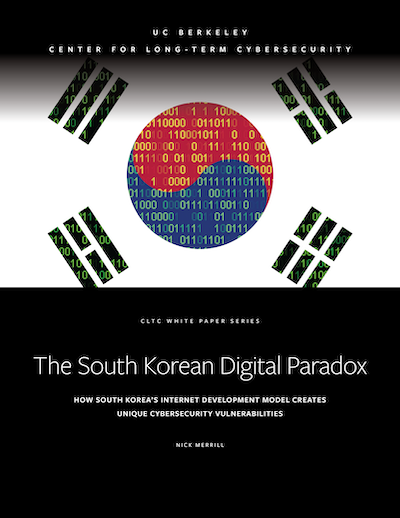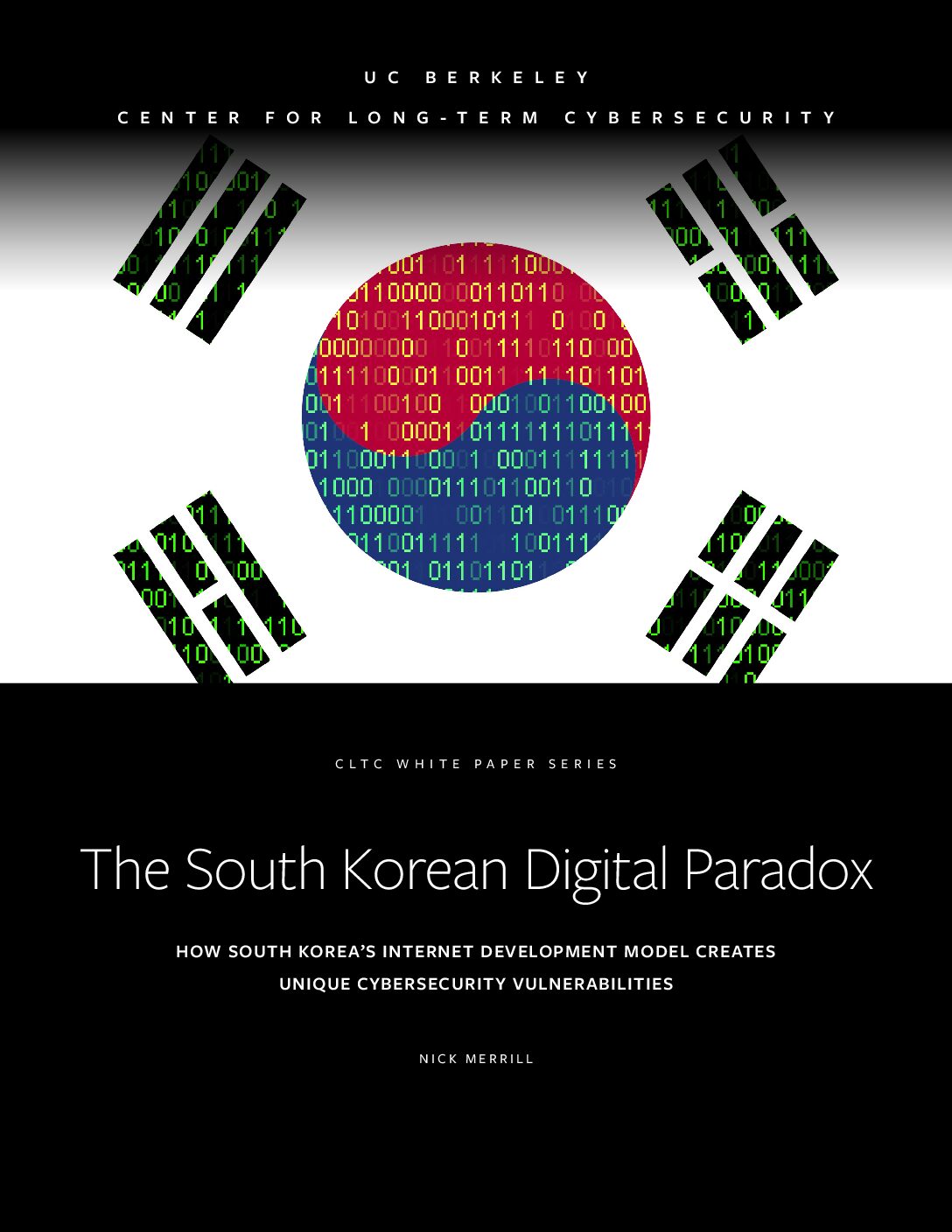
South Korea is home to one of the world’s most robust digital infrastructures, largely as a result of a government-led development model that has favored domestic technologies. Nearly the entire population is online: about 97% of South Koreans use the internet, and a similar percentage own smartphones.
But while South Korea’s approach has led to many benefits, it has also introduced unique security vulnerabilities, according to a new white paper published by the Center for Long-Term Cybersecurity. The report, “The South Korean Digital Paradox: How South Korea’s Internet Development Model Creates Unique Cybersecurity Vulnerabilities,” authored by Nick Merrill, Director of CLTC’s Daylight Security Research Lab, uses scenario analysis to explore the security implications of South Korea’s distinctive model.
South Korea has followed “neither Western market-driven approaches nor Chinese state-control paradigms,” Merrill writes, but rather has fostered “a hybrid ecosystem through state-guided digital industrialization that prioritized domestic platforms and technological sovereignty.” This approach has enabled the country to become a “digital powerhouse with world-leading internet infrastructure and near-universal connectivity.”
Yet South Korea’s emphasis on digital sovereignty has “created an environment where digital ‘home bias’ for domestic platforms shapes infrastructure design and user behavior in ways that external actors can exploit,” Merrill writes. “The state’s role in promoting domestic digital champions has created platform concentration, resulting in critical single points of failure within the national digital ecosystem…. Our analysis reveals that South Korea has developed itself into a ‘digital paradox’: the very factors that enabled its remarkable digital transformation have simultaneously created unique security vulnerabilities.”
A Unique Approach to Digital Governance

South Korea’s internet landscape is defined by a “concentrated platform ecosystem, which is dominated by domestic companies rather than global tech giants,” Merrill writes. The country has a legacy of rejecting products from companies like Microsoft in favor of domestic solutions, and two Korean consumer technology giants — Naver and Kakao — are widely used for communication, search, and other services.
“The prominence of KakaoTalk, Kakao’s flagship chat application, has reached the point where it is considered part of South Korea’s critical infrastructure,” Merrill writes. “The app’s usage is ubiquitous — over 96% of South Koreans use KakaoTalk for communication — and it has evolved far beyond chatting. KakaoTalk is used for work coordination, shopping and bookings, banking authentication, and even as a hotline to government services.”
In the paper, Merrill describes past incidents that indicate how the high level of concentration in these services could expose new vulnerabilities, including a fire at a KakaoTalk data center in 2022 that affected critical communication infrastructure across the nation. The fire itself was limited to a single location, but it paralyzed communication for over 45 million users and disrupted essential services like banking, transportation, and shopping, “revealing how dependent South Korea had become on a single platform for daily functions,” Merrill explains.
Scenario-based Analysis
To explore South Korea’s unique vulnerability patterns, Merrill used scenario-based analysis, which he explains is “a methodology particularly appropriate for examining the interplay between physical infrastructure, software ecosystems, government digital policies, and cyber threats.”
Merrill first conducted in-depth interviews with eight scholars with specialized knowledge of South Korea’s cybersecurity and international relations. He then synthesized interview data with a comprehensive literature review to develop initial scenario frameworks, and asked the experts to review the draft scenarios. He then used the feedback to refine the scenarios. “Throughout this process, we emphasized South Korea-specific vulnerabilities rather than generic cyber threats that could apply to any nation,” Merrill writes.
The scenarios integrated a range of factors specific to the Korean context, including the high degree of nationalism and political polarization among South Koreans, and the fact that citizens may have developed complacency about threats as a result of their past experience with North Korean missile tests.
One of the scenarios, called “The Dark Messenger,” imagines a cyberattack in October 2026 that takes advantage of the KakaoTalk platform, which is privately owned but has become a de facto communications because it is frequently used by the government to share alerts and other information. In the incident, the attackers sow chaos by manipulating data related to banking, transportation, and other systems. “Years of centralization around KakaoTalk had created an ecosystem where even SMS and email were insufficient alternatives,” Merrill writes. “The Emergency Broadcasting System remained functional but couldn’t deliver targeted instructions needed for an asymmetric, geographically distributed incident.”
The second scenario, “The Front Page,” set on March 3, 2026, depicts an incident in which a sophisticated operation targets Naver, South Korea’s primary information gateway, which is used by 28 million users daily. In the scenario, the attackers manipulate Naver’s AI Recommender System (AiRS) to promote the spread of misinformation. “Public discourse increasingly reflected the sentiments pushed in the manipulated information environment,” Merrill writes. “Pre-existing conspiracy theories about election systems gained traction, and political figures from both major parties accused each other of leveraging the situation for electoral advantage — precisely as the operation had intended.”
Broader Implications
The scenarios “demonstrate how platform concentration, digital sovereignty priorities, and government-platform integration create distinctive attack vectors,” Merrill explains. “South Korea’s integration of government services with private platforms has blurred institutional boundaries, creating novel attack surfaces and governance challenges. These vulnerabilities necessitate security approaches that extend beyond the scope of conventional cybersecurity frameworks.”
Merrill provides an overview of implications for policymakers not only in South Korea, but also in other nations. “These findings are not only relevant to South Korean cybersecurity, but also offer contributions to broader academic scholarship and the practice of digital governance,” he writes. “For policymakers and security officials, this research provides a framework for understanding how cultural factors and governance choices create cybersecurity vulnerabilities beyond technical considerations, and offers models for developing ‘sovereign redundancy’ that balances domestic platform preferences with security requirements.”
The report is also relevant to scholars seeking to understand the interplay between technology, security, politics, economics, culture, and other factors. “For international relations scholars, our bridging of internet studies and security frameworks demonstrates how digital architectures embody political choices as much as they do technical optimizations,” Merrill writes. “The paper’s central contribution lies in showing that effective cybersecurity requires comprehending technical systems and the interplay of history, culture, governance, and geopolitics, which play a major (if largely unrecognized) role in shaping how digital infrastructure evolves and what vulnerabilities it manifests.”
Merrill’s analysis also includes lessons for governments working to optimize their approach to governance of internet technologies. “For nations pursuing their own models of technological sovereignty, South Korea’s experience offers a critical case study of both remarkable success and distinctive vulnerabilities,” Merrill explains. “The lesson is not to avoid sovereign digital development, but to ensure that security considerations are integrated from the outset, recognizing that the same policies that enable digital autonomy may simultaneously create novel security challenges requiring equally innovative solutions.”






